N-ACETYLPROCAINAMIDE
- CAS NO.:32795-44-1
- Empirical Formula: C15H23N3O2
- Molecular Weight: 277.36
- MDL number: MFCD00009052
- SAFETY DATA SHEET (SDS)
- Update Date: 2024-11-19 23:02:33
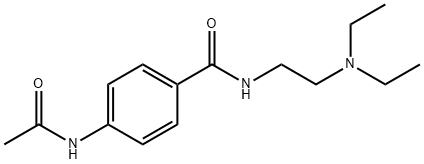
What is N-ACETYLPROCAINAMIDE?
Originator
Acecainide ,ZYF Pharm Chemical
The Uses of N-ACETYLPROCAINAMIDE
antiprotozoal
The Uses of N-ACETYLPROCAINAMIDE
N-acetylprocainamide (NAPA) was used as a model drug in the study of establishing a quantitative approach to predict the renal clearances of basic drugs using N-1-methylnicotinamide (NMN).
What are the applications of Application
N-Acetylprocainamide is used as a model drug in the study of establishing a quantitative approach to predict the renal clearances of basic drugs using N-1-methylnicotinamide
Definition
ChEBI: A benzamide obtained via formal condensation of 4-acetamidobenzoic acid and 2-(diethylamino)ethylamine.
Manufacturing Process
1.0 g of p-amino-N-(2-diethylaminoethyl)benzamide is dissolved in
chloroform. A few ice cubes are added to the solution. Acetyl chloride is added
dropwise with stirring until no more white precipitate forms; the latter is
separated by filtering under suction. The precipitate is washed with cold
acetone and dried overnight in a vacuum oven at room temperature. The
product is dissolved in a minimum amount of hot isopropanol and allowed to
precipitate in the cold. The p-acetamido-N-(2-diethylaminoethyl)benzamide
hydrochloride, is recrystallized a second time from hot isopropanol, melting
point 190°-193°C.
The free base is obtained from the hydrochloride by dissolving the latter in
water, adjusting the pH to greater than 10 with dilute sodium hydroxide, and
adding an equal volume of benzene. After shaking in a separatory funnel, the
benzene layer is recovered and evaporated to dryness. So the p-acetamido-N-
(2-diethylaminoethyl)benzamide is obtained.
Therapeutic Function
Antiarrhythmic
General Description
The relaxant effects of N-acetylprocainamide on bovine tracheal smooth muscle was studied.
Properties of N-ACETYLPROCAINAMIDE
| Melting point: | 138-140 °C(lit.) |
| Boiling point: | 500.0±35.0 °C(Predicted) |
| Density | 1.097±0.06 g/cm3(Predicted) |
| storage temp. | -20°C |
| solubility | soluble1%, clear, colorless to faintly yellow (1N HCl) |
| pka | 14.54±0.46(Predicted) |
| form | Solid |
| color | White to off-white |
| Merck | 13,20 |
Safety information for N-ACETYLPROCAINAMIDE
| Signal word | Warning |
| Pictogram(s) |
 Exclamation Mark Irritant GHS07 |
| GHS Hazard Statements |
H315:Skin corrosion/irritation H319:Serious eye damage/eye irritation H335:Specific target organ toxicity, single exposure;Respiratory tract irritation |
| Precautionary Statement Codes |
P261:Avoid breathing dust/fume/gas/mist/vapours/spray. P264:Wash hands thoroughly after handling. P264:Wash skin thouroughly after handling. P271:Use only outdoors or in a well-ventilated area. P280:Wear protective gloves/protective clothing/eye protection/face protection. P302+P352:IF ON SKIN: wash with plenty of soap and water. P305+P351+P338:IF IN EYES: Rinse cautiously with water for several minutes. Remove contact lenses, if present and easy to do. Continuerinsing. |
Computed Descriptors for N-ACETYLPROCAINAMIDE
New Products
Tert-butyl bis(2-chloroethyl)carbamate (S)-3-Aminobutanenitrile hydrochloride N-Boc-D-alaninol N-BOC-D/L-ALANINOL N-octanoyl benzotriazole 4-Hydrazinobenzoic acid 3,4-Dibenzyloxybenzaldehyde Electrolytic Iron Powder 1,1’-CARBONYLDIIMIDAZOLE R-2-BENZYLOXY PROPIONIC ACID 4-HYDROXY BENZYL ALCOHOL 1,1’-CARBONYLDI (1,2-4 TRIAZOLE) S-2-CHLORO PROPIONIC ACID (2-Hydroxyphenyl)acetonitrile 4-Bromopyrazole 5-BROMO-2CYANO PYRIDINE 5,6-Dimethoxyindanone 5-broMo-2-chloro-N-cyclopentylpyriMidin-4-aMine 3-(Hydroxymethyl)benzoate N-Boc-2-chloroethylamine 1-Bromo-2-methoxy-3-nitrobenzene N-Methyl-3-cyclopenten-1-amine 2-Bromo-3-hydroxybenzaldehyde 1H-indazole-5-carboxamideRelated products of tetrahydrofuran
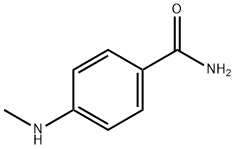


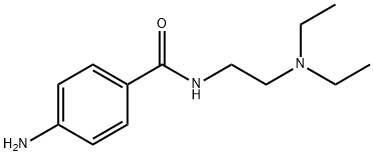
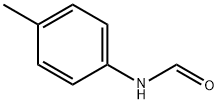

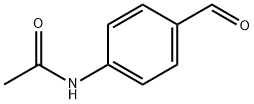

You may like
-
 N-Acetylprocainamide CAS 32795-44-1View Details
N-Acetylprocainamide CAS 32795-44-1View Details
32795-44-1 -
 7441-43-2 98%View Details
7441-43-2 98%View Details
7441-43-2 -
 1260741-78-3 6-Bromo-3-iodo-1-methyl-1H-indazole 98%View Details
1260741-78-3 6-Bromo-3-iodo-1-methyl-1H-indazole 98%View Details
1260741-78-3 -
 4-bromo-3,5-dimethylbenzenesulfonyl chloride 1581266-79-6 98%View Details
4-bromo-3,5-dimethylbenzenesulfonyl chloride 1581266-79-6 98%View Details
1581266-79-6 -
 2490430-37-8 98%View Details
2490430-37-8 98%View Details
2490430-37-8 -
 N-(5-Amino-2-methylphenyl)acetamide 5434-30-0 98%View Details
N-(5-Amino-2-methylphenyl)acetamide 5434-30-0 98%View Details
5434-30-0 -
 124371-59-1 98%View Details
124371-59-1 98%View Details
124371-59-1 -
 53857-52-2 98%View Details
53857-52-2 98%View Details
53857-52-2